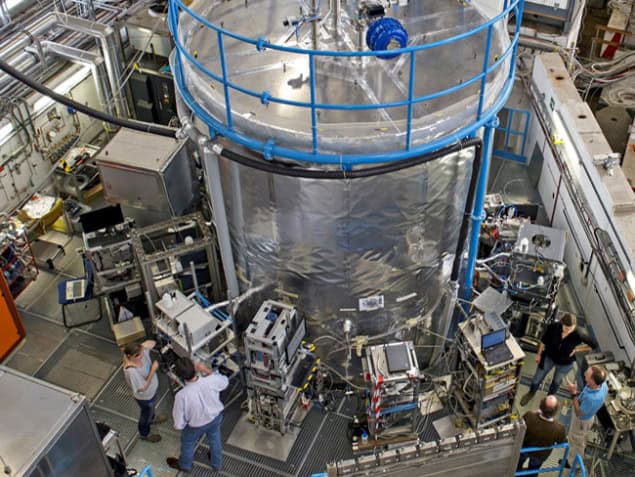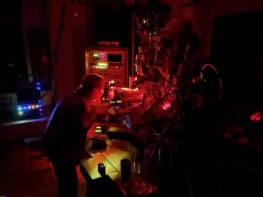The cleanest chamber ever built is allowing researchers at CERN to track the microscopic processes governing cloud formation, finds Matthew Chalmers

In its fifth assessment report published last year, the Intergovernmental Panel on Climate Change identified atmospheric aerosols and their influence on clouds as the largest source of uncertainty in current climate models. Hundreds of these tiny particles – ranging from a few nanometres to a few micrometres across – are present in every cubic centimetre of atmosphere, with higher concentrations in urban environments. In addition to cooling the climate by reflecting or absorbing solar radiation, atmospheric aerosols also provide the seeds for all cloud droplets. Some cloud seeds enter the atmosphere directly from dust or sea spray, but around half are produced indirectly by the nucleation of trace vapours to form tiny molecular clusters that grow under condensation.
This process is poorly understood, but an experiment called CLOUD at CERN, the particle-physics laboratory in Geneva, is now providing scientists with some unique perspectives on it. At its heart is a electropolished stainless-steel cylinder – with a volume of roughly 26 m3 – in which researchers recreate a portion of the atmosphere under precisely controlled conditions. Earlier this year, the 50-strong CLOUD collaboration reported its latest results, revealing that biogenic vapours emitted by trees have a significant impact on the formation of aerosols and clouds that helps cool the planet.
“The reason why it has taken so long to understand the vapours responsible for new particle formation is that they are present in minute amounts near one molecule per trillion air molecules,” explains CLOUD spokesperson Jasper Kirkby of CERN. “Reaching this level of cleanliness and control is at the limit of current technology, and CERN’s expertise in materials, gas systems and ultra-high-vacuum technologies has been crucial,” he says.
Cosmic origins
CLOUD, which stands for Cosmics Leaving Outdoor Droplets, is designed to explore the link between galactic cosmic rays and cloud formation. First proposed in the 1970s, the idea is that charged particles that strike the Earth’s atmosphere produce ions that help new aerosol particles nucleate. To mimic such processes the CLOUD chamber is bombarded by beams of charged pions from CERN’s Proton Synchrotron.
A bespoke gas system and strict use of clean materials in the chamber lets the CLOUD researchers get much lower concentrations of contaminants than in previous experiments. Indeed, the team even produces its own synthetic air from cryogenic liquid oxygen and nitrogen, since natural air cannot be purified sufficiently. The temperature of the chamber can be varied between +30 °C and –70 °C and kept steady to within 0.01 °C, allowing researchers to reproduce any region of the troposphere. In order to simulate sunlight, which is necessary for photolytic reactions, the chamber is fitted with ultraviolet lamps linked to a quartz fibre-optic system and 250 optical-fibre vacuum feedthroughs.
In 2011 CLOUD reported its first results, revealing that trace sulphuric-acid and ammonia vapours at high altitudes can rapidly cause clusters to nucleate and become the seeds for clouds. The results also showed that ionization from cosmic rays can make nucleation occur up to 10 times faster. On the other hand, the data showed that these vapours could only account for 1000th of the rate of actual aerosol formation observed at low altitudes (Nature 476 429).
Two years later, the collaboration showed that amines – derivatives of ammonia – in concentrations of a few parts per trillion can stabilize sulphuric-acid particles and better reproduce the observed particle formation rates (Nature 502 359). Yet unlike sulphuric acid, which enters the atmosphere mainly through coal-fired power plants, amines are only found close to primary sources such as farms. This suggested that additional vapours must be at work.
Biogenic source
CLOUD’s latest results show that sulphuric-acid aerosols do indeed have a significant influence on the formation of clouds, but only if they are stabilized by volatile biogenic vapours emitted by trees (Science 344 717). These vapours, which give pine forests their characteristic smell, are rapidly oxidized in the atmosphere to produce low-volatility vapours that participate in the formation of new aerosol particles. When the researchers modelled the global impact of the new process, they were able to account for the observed seasonal variations in atmospheric aerosol concentrations for the first time.
According to Ian Ford, a condensed-matter theorist at University College London who is not involved in the experiment, the result represents a significant step forward in climate science. “CLOUD is one of the best experimental rigs in the world and the wide range of atmospheric conditions that it covers means that we can now better parameterize the impact of aerosols and clouds in global climate models,” he says.
The CLOUD team is now studying how nucleation rates vary under different conditions, vapour concentrations and particle-beam intensities, and the experiment will run for 10 more years. “We are confident that it will settle the link between cosmic rays and cloud formation, while also reducing uncertainties in anthropogenic aerosol-cloud changes,” says Kirkby.



